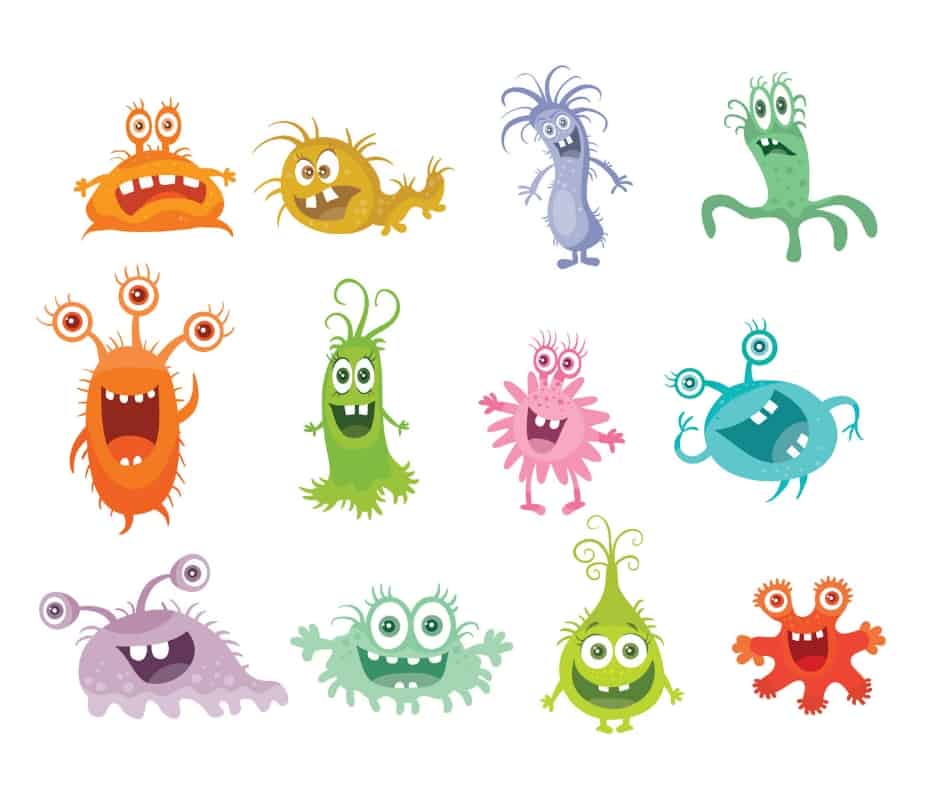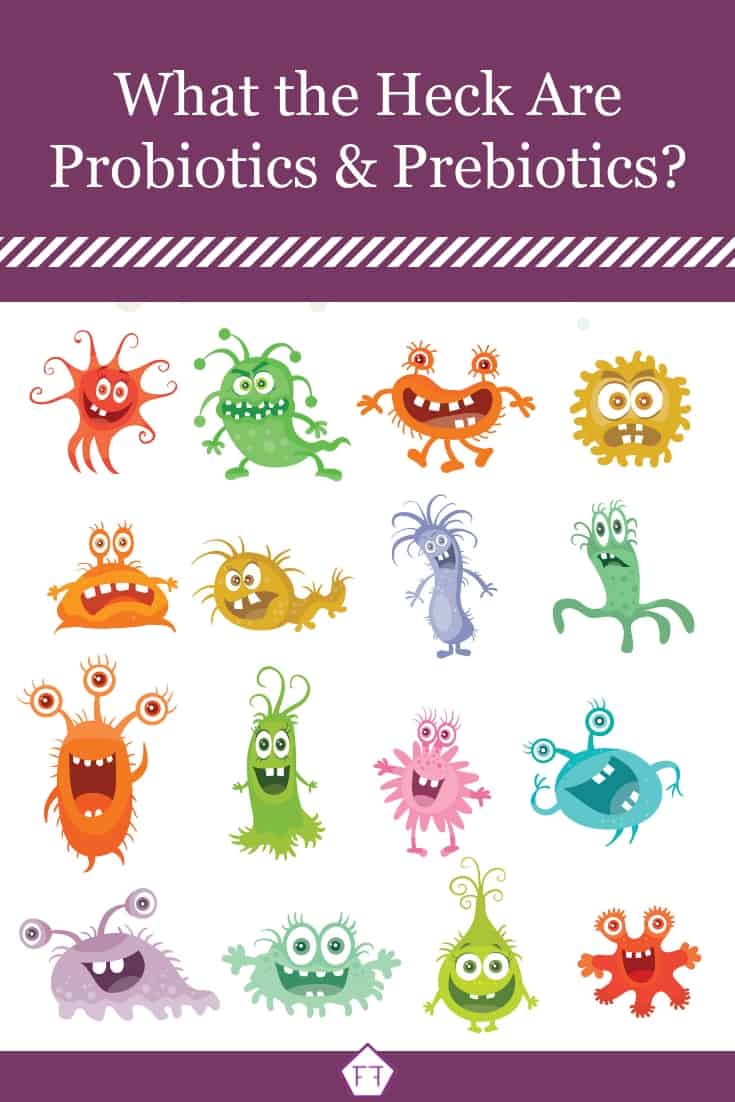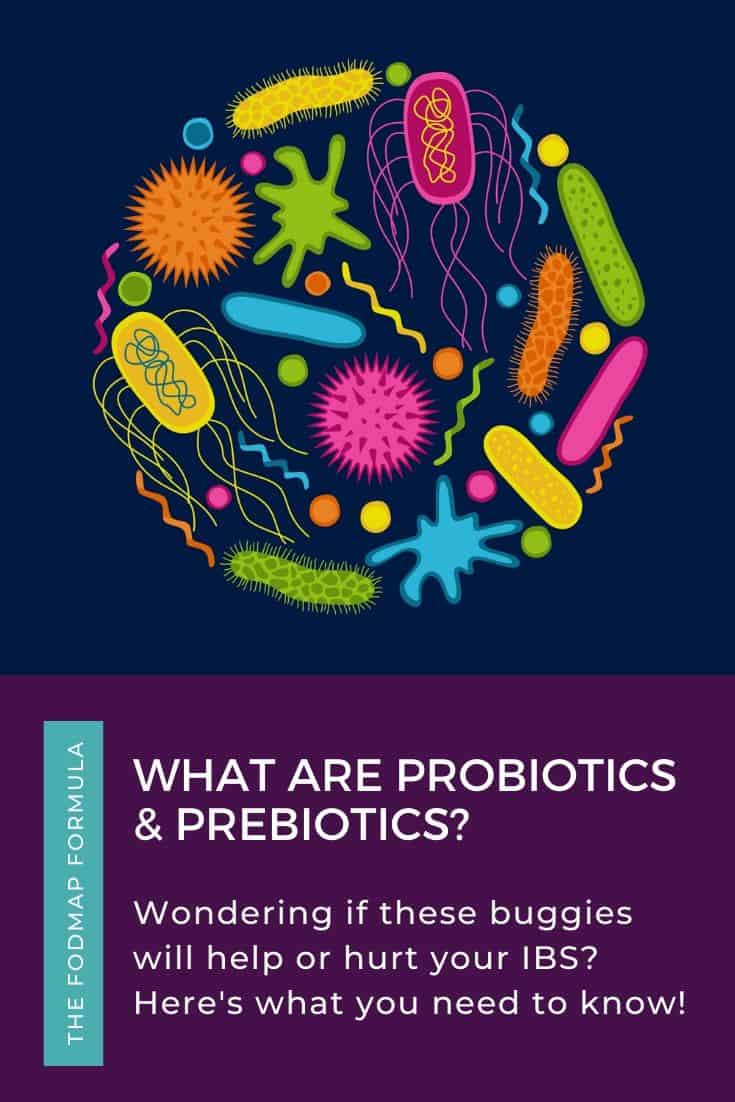Wondering if probiotics or prebiotics can help manage your IBS symptoms? This article will explain what probiotics and prebiotics are and what they can do for your body. Grab your spectacles, friend! I’m about to get my nerd on!

Understanding Your Native Gut Flora
Did you know that over 40 trillion bacteria cells live inside your digestive tract? These tiny microorganisms make up your natural gut flora; also known as your “microbiome” or your “microbiota.” Every person has their own unique mix of bacteria. The kind of gut bugs you develop depends mainly on your genes, the bacteria you were exposed to during birth, and your diet.
Fun fact, your microbiome is so unique, it’s being researched as an emerging field of forensic science! What?!
Lately, lots of research has been popping up about the microbiome. Some of which has shown a clear difference between healthy people and people with conditions like Irritable Bowel Syndrome (IBS). But, more research is needed to define the specific kind and number of bacteria that make up a healthy human microbiota.
What Are Probiotics?
You’ve probably heard murmurs by now that probiotics may help tame your digestive symptoms. But, what are probiotics? And how do they work?
First of all, probiotics are living microorganisms that have shown through research they can improve human health when ingested in the proper dose. It’s worth noting commercial probiotics don’t stay in your digestive system long-term. They’re house guests, not tenants. That means if you want to take a probiotic, you’ll need to take it consistently for it to impact your body.
FYI, common probiotic species include Lactobacillus and Bifidobacterium. Some E. coli and Bacillus species and yeast like Saccharomyces boulardii may also be used. But, they’re less common.
While many probiotic species have similar benefits, some have special skills. For example, research has shown Lactobacillus plantarum 299v is particularly helpful with abdominal pain while Lactobacillus rhamnosus NCIMB 30174 can help with the consistency of bowel movements. You can get a full list of commercially available probiotic species and strains, and their specialties here.

How Can Probiotics Help You?
So, how can a probiotic help improve your IBS symptoms? First of all, adding more good bacteria can temporarily change the ecosystem in your gut. This can happen a few ways. For example, some bacteria help change the pH balance in your gut. This makes it harder for bad bacteria to survive. Some probiotic bacteria can also help signal the body’s immune system when they encounter bad bacteria. This makes it easier for your body to locate and remove bad bacteria.
Fun fact! When probiotic bacteria digest our food, they produce vitamins and short-chain fatty acids the body can’t produce on its own. When you add extra probiotics into the mix, you not only get more helping hands, but there is higher competition for food between good and bad bacteria. Essentially, starving out some of the bad guys.
What Is the Recommended Dose of Probiotics for IBS?
So, how many probiotic organisms should you be ingesting daily? The most effective dose will depend on the strain and the product you’re using. Even though many over-the-counter products have somewhere between 1-10 billion CFU (colony forming units) per dose, research has shown some strains are effective in much lower numbers.
For example, research has shown the strain Bifidobacterium longum 35624 (used in the product Align) can reduce IBS symptoms in doses as low as 100 million CFU per day. While the probiotic VSL#3 requires three packets of 300-450 billion CFU three times per day.
Because scientists don’t know what number of which bacteria make up a “healthy” microbiome, currently there is no standard on what a “proper” dose of probiotics looks like. Instead, researchers suggest the recommended dose for each probiotic should be based on human studies that show a clear benefit at a specific dose.
What Are Prebiotics?
Prebiotics are dietary compounds that aren’t digested by the body and have a positive impact on your microbiome. Think of them like a bagged lunch for your gut bugs.
Most prebiotics come directly from your diet. They’re often carbohydrates, like fructans (found in onion, garlic, leeks, wheat, inulin etc.) and galactooligosaccharides or GOS (found in beans, nuts, seeds, etc.).
Prebiotics are a bit of a double-edged sword for people with IBS. Since prebiotic foods are highly fermentable, they’re like a super-food for your gut bacteria. This can help increase the number of good bacteria (especially Bifidobacteria) in your digestive system and keep them nice and healthy.
But, prebiotics can also throw a monkey wrench in your system if they’re not digested normally (like in IBS). For example, many foods tested in the Low FODMAP Diet are prebiotics. If you’re familiar with the low FODMAP program, you’ll know that an overabundance of prebiotic foods in the large intestine can create a wide range of digestive symptoms for people with IBS.
This means people following programs like the Low FODMAP Diet need to walk a fine line between managing their IBS symptoms and making sure their gut bugs have enough food to eat.
In fact, according to studies by The Journal of Nutrition and Stanford University, your good gut bacteria can start dying off after only 4 weeks of a prebiotic-restricted diet. These studies also show this process may be irreversible. This is one of the reasons the elimination phase of the low FODMAP diet is limited to 6 weeks. If you’ve been following the elimination phase diet for longer than that, don’t panic. You can grab instructions on how to complete the re-challenge phase here.
Final Thoughts
Both probiotics and prebiotics are an essential part of a healthy gut. While there are many different genera, species, and strains of probiotics, researchers agree they can be beneficial to our digestive health. Scientists are also certain that the key to probiotic health is providing our gut bugs with prebiotics to eat. While these highly fermentable foods can cause issues for people with IBS, it’s important to strike a balance between managing our symptoms and keeping our gut bugs happy and healthy.
You might also like one of these:
3 Common Myths About the Low FODMAP Diet Starting the low FODMAP program can be complicated. Have you fallen prey to these common myths about the Low FODMAP Diet?
When Should You Start the Low FODMAP Diet? Wondering if the Low FODMAP Diet is right for you? This article can help you decide if and when you should start the Low FODMAP Diet.
What Is Referred Pain? You know IBS can be a pain in the butt! But did you know it can also be a pain in the back? Check out this article for everything you need to know about referred pain!
If you like this post, don’t forget to share it! Together we’ll get the low FODMAP diet down to a science!
References
- Felis, G. E., & Dellaglio, F. (2015). Taxonomy of Lactobacilli and Bacteria. Issues Intestinal Microbiol,8, 44-61. Retrieved from https://www.caister.com/ciim/v/v8/05.pdf.
- Gibson, G. R., & Roberfroid, M. B. (1995). Dietary Modulation of the Human Colonic Microbiota: Introducing the Concept of Prebiotics. The Journal of Nutrition,1401-1412. Retrieved from https://www.ilri.org/biometrics/Publication/Abstract/Case study 17 -1.pdf.
- Hampton‐Marcell, J. T., Lopez, J. V., & Gilbert, J. A. (2017, March). The human microbiome: An emerging tool in forensics. Retrieved from https://www.ncbi.nlm.nih.gov/pmc/articles/PMC5328825/
- Probiotics in Food: Health and nutritional properties and guidelines for evaluation[PDF]. (n.d.). FAO/WHO.
- De Paula, J., Eliakim, R., Fedorak, R., Gangl, A., Garisch, J., Kaufmann, P., . . . Guarner, F. (2017, February). Probiotics and Prebiotics [PDF]. Milwaukee: World Gastroenterology Organization Global Guidelines.


